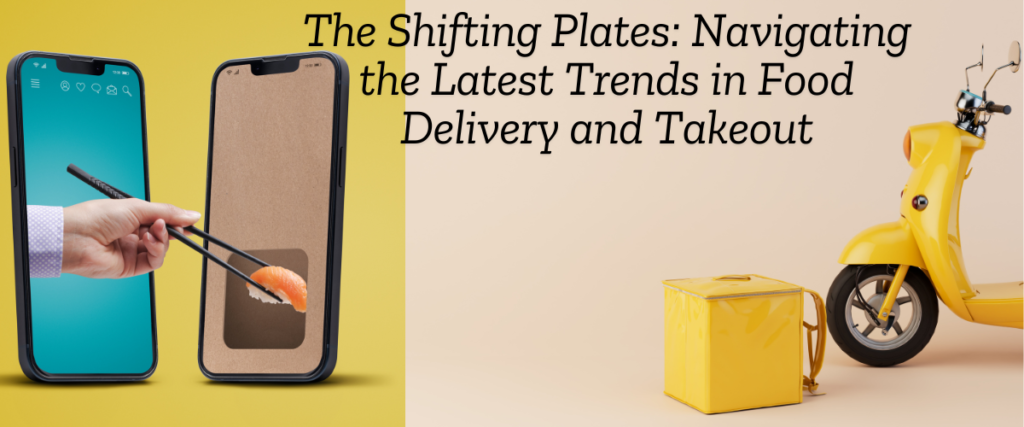The humble act of ordering food has undergone a seismic transformation. Gone are the days of dog-eared menus and busy phone lines. Today, a world of culinary delights is accessible with a few taps on a smartphone, delivered to your doorstep with unprecedented speed and convenience. The food delivery and takeout industry has not only adapted to the digital age but is actively shaping it, driven by technological advancements, evolving consumer preferences, and global events. Let’s delve into the latest trends redefining how we experience food beyond the restaurant table.
1. The Rise of Third-Party Delivery Platforms: A Digital Marketplace for Food
The dominance of platforms like Uber Eats, DoorDash, Grubhub, and Deliveroo continues to reshape the landscape. These platforms have evolved beyond simple order aggregation, becoming sophisticated logistical hubs that connect restaurants, drivers, and customers.
- Algorithmic Optimisation: These platforms leverage advanced algorithms to optimise delivery routes, predict demand, and make personalised recommendations. It translates to faster delivery times, reduced costs, and a more tailored user experience.
- Expansion of Services: Beyond restaurant meals, these platforms are now integrating grocery delivery, alcohol delivery, and even retail partnerships. This diversification facilitates their capture of a larger share of the consumer’s wallet, making it a one-stop shop for convenience.
- Subscription Models: Subscription services like DoorDash DashPass and Uber Eats Pass offer customers perks like waived delivery fees and exclusive discounts, fostering loyalty and increasing order frequency.
2. Ghost Kitchens and Virtual Restaurants: The Digital-First Dining Experience
The concept of ghost kitchens, also known as virtual restaurants or cloud kitchens, has exploded in popularity. These facilities focus solely on delivery and takeout, operating without a traditional storefront or dine-in space.
- Reduced Overhead: Ghost kitchens significantly lower operating costs by eliminating the need for expensive real estate and front-of-house staff.
- Menu Experimentation: These kitchens enable restaurants to experiment with new cuisines and concepts without the risk of a full-scale restaurant launch. They can swiftly adapt their menus based on real-time data and customer feedback.
- Data-Driven Decision Making: Ghost kitchens leverage data analytics to optimise menu offerings, predict demand, and identify popular dishes, increasing efficiency and profitability.
- Virtual Brands: A virtual brand is a delivery-only concept hosted within an existing restaurant or a ghost kitchen. It allows existing restaurants to expand their offering without building a new one.
3. Sustainability and Eco-Conscious Packaging: A Greener Approach to Delivery
Consumers are increasingly anxious about the environmental impact of food delivery and takeout, leading to a growing demand for eco-conscious practices and eco-friendly packaging.
- Biodegradable and Compostable Packaging: Restaurants and delivery platforms are transitioning to biodegradable and compostable packaging materials from plant-based sources.
- Reusable Containers: Some restaurants offer reusable container programs, incentivising customers to return containers for cleaning and reuse.
- Electric Vehicle Delivery: Delivery platforms invest in electric vehicle fleets to decrease their carbon footprint.
- Reducing Food Waste: Using data to forecast demand can accurately minimise food waste. Partnerships with food waste reduction apps are also increasing.
4. Contactless Delivery and Enhanced Safety Measures: Prioritising Hygiene
The COVID-19 pandemic accelerated the adoption of contactless delivery and heightened awareness of food safety.
- No-Contact Delivery Options: Delivery platforms continue to offer no-contact delivery options, allowing customers to receive their orders without direct interaction with the driver.
- Enhanced Hygiene Protocols: Restaurants and delivery platforms have implemented stricter hygiene protocols, including regular sanitisation, temperature checks, and mandatory mask-wearing for staff.
- Transparent Food Handling Practices: Customers demand greater transparency regarding food handling practices, with restaurants providing detailed information about hygiene and safety measures.
5. Personalisation and Customisation: Catering to Individual Preferences
Consumers seek personalised dining experiences catering to their specific dietary needs and preferences.
- Customisable Menu Options: Restaurants offer greater flexibility in menu customisation, allowing customers to tailor their orders based on dietary restrictions, allergies, and personal preferences.
- AI-Powered Recommendations: Delivery platforms leverage artificial intelligence to personalise recommendations based on past orders, nutritional preferences, and location.
- Subscription Boxes and Meal Kits: Meal kits and subscription box services are becoming increasingly popular, offering curated selections of ingredients and recipes tailored to specific dietary needs and preferences.
6. Quick Commerce (Q-Commerce): The Need for Speed
Q-commerce, or quick commerce, is a new trend focusing on speedy delivery times, often within 15-30 minutes. It is usually achieved using smaller, local warehouses or “dark stores” closer to consumers.
- Instant Gratification: Q-commerce caters to the growing demand for instant gratification, providing customers with groceries, meals, and other essentials in minutes.
- Hyperlocal Delivery: Q-commerce platforms focus on hyperlocal delivery, utilising a small, strategically located warehouse network to ensure rapid delivery times.
- Technology-Driven Logistics: Q-commerce relies on advanced technology, including real-time inventory management, route optimisation, and automated dispatch systems, to achieve ultra-fast delivery speeds.
7. Social Commerce and Influencer Marketing: Leveraging Social Media
Social media platforms are increasingly vital in shaping food delivery and takeout trends.
- Influencer Partnerships: Restaurants and delivery platforms partner with social media influencers to boost and elevate their products and services.
- User-Generated Content: Customers share their food delivery experiences on social media, creating a powerful form of word-of-mouth marketing.
- Live Commerce: Live commerce platforms enable restaurants to showcase their dishes and interact with customers in real-time, driving sales and engagement.
- Social Media Ordering: Platforms are integrating with social media apps to enable direct ordering, reducing friction in the purchasing process.
8. The Integration of Robotics and Automation:
The future of delivery includes robotics.
- Delivery Robots: Autonomous delivery robots are being trialled and deployed in various cities, offering a cost-effective and efficient way to deliver food in densely populated areas.
- Automated Kitchens: Automated Kitchen Systems are being designed to automate food preparation and cooking, increasing efficiency and decreasing labour costs.
- Drone Delivery: While still in its primordial stages, drone delivery has the potential to revolutionise food delivery, particularly in remote areas.
Conclusion
Technology and innovation are changing the food delivery and takeout space by providing new solutions to meet these needs under a sweeping sustainability lens and consumer-driven corrections. The trends mentioned in this blog show the way to a more personalised, efficient and eco-conscious dining experience. With rising technology consumer demands, we hope to see more exciting developments in this constantly changing and progressive field. Food delivery will no longer be a matter of transporting meals from a kitchen to a door; it will focus, instead, on providing a seamless and pleasant dining experience that transcends traditional restaurant-dining paradigms.
Disclaimer
The information provided in this blog is for general knowledge and informational purposes only and is not construed as professional advice. As food delivery and takeouts evolve, staying relevant is crucial; however, these trends may not apply to every region and business. Readers are encouraged to conduct their research and confer with appropriate professionals before making decisions related to the food delivery and takeout industry.


